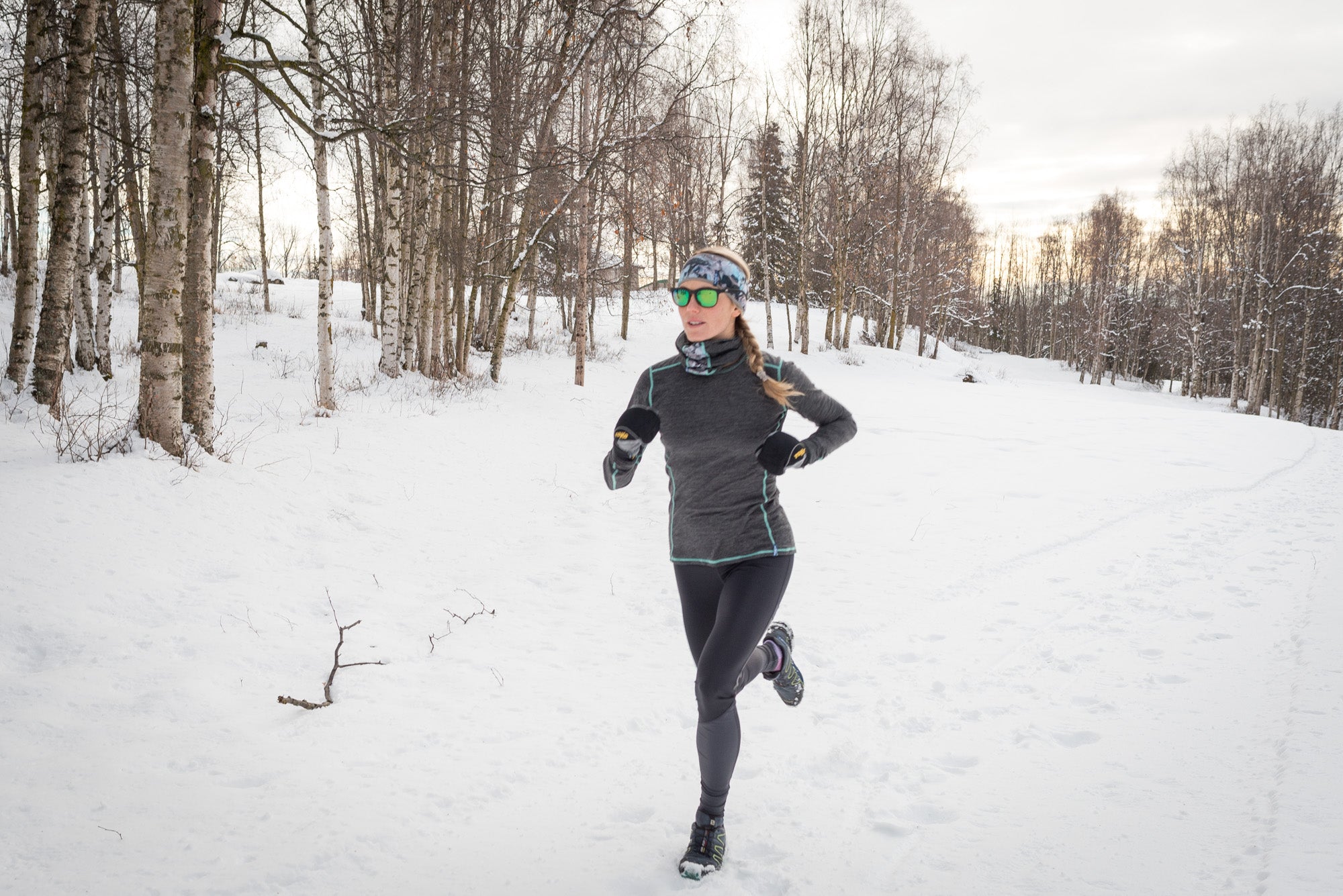Such a highly-aerobic sport requires an acute attention to gear choices. Intimate knowledge of your gear, how it functions, what it is meant for, and what else is out there will improve your chances of a good fun run. My primary concern is the temperature at the time of the run so I have taken the liberty of breaking down my gear choices by temperature. A running backpack can be invaluable to store extra gear as you inevitably heat up and strip down; it also doubles as an extra layer. Overall I try to take the approach of starting off cold rather than warm since I will certainly warm us as I get moving.
Gear for 40-50 F
Maybe not truly cold, but some adjustments need to be made. I’m usually comfortable in a long sleeve base layer shirt and shorts. Depending on rain or wind maybe some light gloves and an unlined headband but they will probably come off pretty quick and tucked into my waistband or a pocket if I have one. On a sunny day if the temperature is rising I’ll probably wear a short sleeve.
Gear for 33-40 F
I’m definitely in an Alpine Fit long sleeve. I’ll sometimes throw a short sleeve over that for extra warmth, especially if I don’t have a backpack. Shorts trending towards lightweight running pants. Gloves and headband are again optional but usually brought and packed half way into the run. Depending on conditions, footwear can be tricky. Shoes with large lugs can be handy for soft snow or slick mud.
Gear for 25-32 F
This can be a finicky temperature range. Depending on your comfort level, a long sleeve plus a vest or additional t-shirt, or long sleeve plus windbreaker. I’ll probably end up sweating either way. Lightweight running pants are important here, I’ve found the best are cross-country ski pants or bushwhacking leggings. Alpine Fit headband or merino wool hat, light gloves, no neck gaiter. At this temperature I’ll wear my studded shoes. I have found that screw-in studs are not as durable or comfortable as Ice Bugs. Plus the ice-bugs come with a sealed-in toe box and less mesh on the forefoot so they are definitely warmer. Alternatively, Microspikes can be worn with any running shoe and provide great traction.

Gear for 15-25 F
We can start layering up here. Hat, gloves, wool socks. Neck gaiter for some but only if it’s windy. Alpine fit long sleeve base layer top with soft shell. Running pants are still lightweight like bushwhacking leggings. Icebug shoes.

Gear for 0-15 F
Layers only get thicker from here. Gloves are medium thickness, often light mitts. Wool hat plus Alpine Fit neck gaiter. I have a heavier weight running/xc skiing pant that I wear in these conditions. On top I’m probably still just in a base layer plus a softshell, making sure to zip up all vents and cinch in the waistband.

Gear for Less than 0 F
These temperatures are only for the intrepid runner, willing to brave the cold. I’ve been scared back inside on a couple of -20F days when I was under-dressed. Usually I’m the only one on the trails in these conditions but it’s nice to see some others once in a while. On top I wear an Alpine Fit base layer, softshell and a thin down puffy over that. On bottom, Alpine Fit base layer and Schoeller pants. Larger shoes that will accommodate thick socks and toe warmers. Warm hat, warm gloves, warm neck gaiter.







2 comments
Olmo
MY TESTIMONY ON HOW COINSRECOVERYWORLDWIDE HELP ME RECOVER BACK MY LOST CRYPTO
Yesterday, I confirmed the recovery of my scammed coins.. I just want to put this out there that this is possible and not a miracle.. I was scammed of $35,000 btc and I was blocked off the account.. It was a problem for me, not being able to access my money and my account regardless of speaking to the help service COINSRECOVERYWORLDWIDE . Thanks to coinsrecoveryworldwide at gmail dot com or 📞 +1(737)368-8915(whatsapp). Today being 2nd January 2025 am a happy man for having all my funds back in my position COINSRECOVERYWORLDWIDE keep to there words and handle the situation with a good technology
©2025 COINSRECOVERYWORLDWIDE
101 N BRAND BLVD. 11TH FLOOR GLENDALE CA 91203. #investing #financialfreedom #crypto #bitcointrading #investmentstrategy #altcoins #bitcoinnews #investor #bitcoinprice #bitcoinmining #bitcoinexchange #bitcoinwallet #bitcoincommunity #bitcoinmarket #bitcointrader #bitcoinbusiness #bitcoinexpert#BITCOINSRECOVERY #STOLENBITCOINS #FOREX #USDT
Patricia Lovick
How To Recover Your Bitcoin Without Falling Victim To Scams: A Testimony Experience With Capital Crypto Recover Services, Contact Telegram: @Capitalcryptorecover
Dear Everyone,
I would like to take a moment to share my positive experience with Capital Crypto Recover Services. Initially, I was unsure if it would be possible to recover my stolen bitcoins. However, with their expertise and professionalism, I was able to fully recover my funds. Unfortunately, many individuals fall victim to scams in the cryptocurrency space, especially those involving fraudulent investment platforms. However, I advise caution, as not all recovery services are legitimate. I personally lost $273,000 worth of Bitcoin from my Binance account due to a deceptive platform. If you have suffered a similar loss, you may be considering crypto recovery, The Capital Crypto Recover is the most knowledgeable and effective Capital Crypto Recovery Services assisted me in recovering my stolen funds within 24 hours, after getting access to my wallet. Their service was not only prompt but also highly professional and effective, and many recovery services may not be trustworthy. Therefore, I highly recommend Capital Crypto Recover to you. i do always research and see reviews about their service, For assistance finding your misplaced cryptocurrency, get in touch with them, They do their jobs quickly and excellently, Stay safe and vigilant in the crypto world.
You can reach them via email at Capitalcryptorecover@zohomail.com